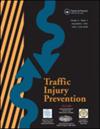Enhancing highway Loop Safety Level through proactive risk-based assessment of geometric configuration using lateral acceleration
IF 1.6
3区 工程技术
Q3 PUBLIC, ENVIRONMENTAL & OCCUPATIONAL HEALTH
引用次数: 0
Abstract
Objective
Loop ramps are complex due to their combination of horizontal curves and vertical alignments. Analyzing driving behavior and measuring safety levels can provide insights for designers, helping to improve the performance and alignment of design assumptions with actual driving behavior on loops. Therefore, the primary objective of this research is to explore the safety, performance and geometric configuration of the main body and general shape of free-flow loop ramps in the free-following mode.
Methods
The study uses data from a UAV to investigate vehicle demand behavior. Maximum lateral acceleration (ay,i) in loops is used as a Surrogate Safety Measure (SSM), along with a new parameter, the a/b ratio, to determine the general shape of loop bodies. The study presents the Loop Safety Level (LSL), an approach for proactive risk analysis and ranking that relies on threshold lateral acceleration (at), 85th percentile maximum lateral acceleration (y,max,85%), and crash analysis.
Results
A higher LSL value points to a more critical safety concern regarding the loop’s shape in relation to lateral acceleration caused by driving behaviors. Comparing crash statistics with lateral acceleration results enables the LSL to provide appropriate safety ratings and diagnose loop segment safety. A prediction model for maximum lateral acceleration, based on loop geometry, demonstrates a good fit (R2=0.88) between observed and predicted data.
Conclusions
The study enhances understanding of safety considerations in geometric configuration and general shape enhancement of loops during the design process.
利用横向加速度对几何构造进行基于风险的主动评估,提高高速公路环路安全等级。
目的:环形坡道由于结合了水平曲线和垂直排列,因此非常复杂。分析驾驶行为和测量安全等级可为设计者提供见解,有助于提高性能,并使设计假设与环路上的实际驾驶行为保持一致。因此,本研究的主要目的是探索自由跟车模式下的安全、性能以及自由流环形坡道主体和总体形状的几何构造:研究使用无人驾驶飞行器的数据来调查车辆的需求行为。环路中的最大横向加速度(ay,i)被用作替代安全度量(SSM),同时使用新参数 a/b 比率来确定环路主体的一般形状。研究提出了环路安全等级 (LSL),这是一种主动风险分析和排名方法,依赖于阈值横向加速度 (at)、第 85 百分位数最大横向加速度 (ay,max,85%)和碰撞分析:结果:LSL 值越高,说明环路形状与驾驶行为造成的横向加速度之间的安全关系越密切。将碰撞统计数据与横向加速度结果进行比较,可使 LSL 提供适当的安全等级并诊断环路段的安全性。基于环路几何形状的最大横向加速度预测模型表明,观测数据与预测数据之间的拟合度很高(R2=0.88):这项研究加深了人们对设计过程中环路几何配置和一般形状增强的安全考虑因素的理解。
本文章由计算机程序翻译,如有差异,请以英文原文为准。
求助全文
约1分钟内获得全文
求助全文
来源期刊

Traffic Injury Prevention
PUBLIC, ENVIRONMENTAL & OCCUPATIONAL HEALTH-
CiteScore
3.60
自引率
10.00%
发文量
137
审稿时长
3 months
期刊介绍:
The purpose of Traffic Injury Prevention is to bridge the disciplines of medicine, engineering, public health and traffic safety in order to foster the science of traffic injury prevention. The archival journal focuses on research, interventions and evaluations within the areas of traffic safety, crash causation, injury prevention and treatment.
General topics within the journal''s scope are driver behavior, road infrastructure, emerging crash avoidance technologies, crash and injury epidemiology, alcohol and drugs, impact injury biomechanics, vehicle crashworthiness, occupant restraints, pedestrian safety, evaluation of interventions, economic consequences and emergency and clinical care with specific application to traffic injury prevention. The journal includes full length papers, review articles, case studies, brief technical notes and commentaries.
 求助内容:
求助内容: 应助结果提醒方式:
应助结果提醒方式:


